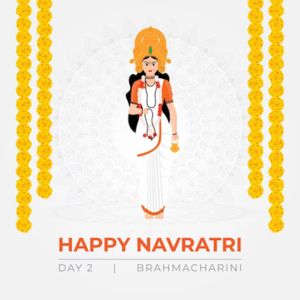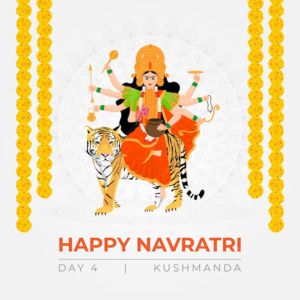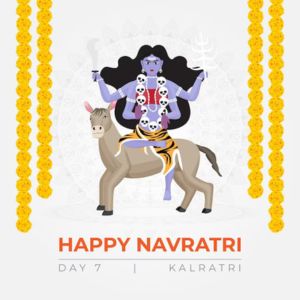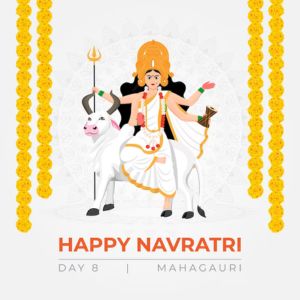Navratri is a vibrant and widely celebrated Hindu festival that spans nine nights and ten days, dedicated to the worship of Goddess Durga. One of the unique and visually striking aspects of Navratri is the tradition of wearing different colors on each day of the festival. These colors hold deep significance in Hindu culture and are believed to reflect the various forms and attributes of the divine feminine energy. In this article, we will explore how are colours of Navratri decided and the spiritual meaning behind each hue.

The Spiritual Significance of Colors
Colors play a significant role in Hindu spirituality, and they are often associated with different deities, rituals, and emotions. The colors of Navratri are carefully selected to represent the various manifestations of Goddess Durga and are believed to invoke blessings and positive energy during the festival.
Also Read: 9 Days of Navratri: Devi Names and Colours
How are Colours of Navratri Decided?
How are colours of Navratri decided can vary depending on regional and cultural traditions. However, in many parts of India, the colors for each day of Navratri are based on the nine forms of the Goddess Durga, also known as Navadurga. Each form is associated with a specific color and has a unique significance. The choice of colors for Navratri may also be influenced by astrological and spiritual beliefs.
Day 1: Pratipada

On the first day of Navratri, the color red is often associated with the Goddess Shailaputri, who is considered the first form of Goddess Durga. Shailaputri is believed to be the daughter of the Himalayas, and “Shaila” means mountain, while “putri” means daughter. She is usually depicted riding a bull and holding a trident in one hand and a lotus flower in the other. The red color represents power, strength, and action, which are attributes associated with this form of the goddess.
Day 2: Dwitiya

The second day of Navratri is often associated with the Goddess Brahmacharini, who is the second form of Goddess Durga. The word “Brahmacharini” is derived from “Brahma,” which refers to the divine, and “acharini,” which means one who practices or follows.
Goddess Brahmacharini is often depicted in white or royal blue attire, holding a rosary in one hand and a water pot (kamandalu) in the other. She is known for her spiritual and penance-seeking nature. The royal blue color may be chosen to represent her divine and meditative qualities.
Day 3: Tritiya

On the third day of Navratri, the Goddess Chandraghanta is worshipped, and she is often depicted wearing yellow attire. Chandraghanta is the third form of Goddess Durga and is known for her fierce and protective nature. Her name is derived from two words: “Chandra,” which means moon, and “Ghanta,” which means bell. She is typically depicted with a half-moon-shaped bell (ghanta) on her forehead.
The yellow color associated with Chandraghanta is believed to symbolize happiness, optimism, and positive energy. It represents the bright and radiant aspect of the goddess, as well as her divine grace and strength. Yellow is often considered an auspicious color in Hinduism and is associated with purity and spirituality.
Day 4: Chaturthi

On the fourth day of Navratri, the Goddess Kushmanda is worshipped, and she is often associated with the color green. Goddess Kushmanda is the fourth form of Goddess Durga and is believed to represent creative energy and the cosmic egg. The name “Kushmanda” is derived from two words: “Ku,” which means little, “Ushma,” which means warmth or energy, and “Anda,” which means egg. She is typically depicted as having eight or ten arms and is often shown riding a lion.
The green color associated with Kushmanda symbolizes new beginnings, growth, and the life-sustaining force of nature. Green is often associated with fertility, abundance, and renewal in Hindu culture. As the goddess of energy and creation, Kushmanda is believed to provide the energy needed for the universe to come into existence and flourish.
Day 5: Panchami

On the fifth day of Navratri, the Goddess Skandamata is worshipped. She is the fifth form of Goddess Durga and is often depicted holding her son, Lord Skanda (also known as Lord Kartikeya), in her lap. The name “Skandamata” is derived from two words: “Skanda,” which is another name for Lord Kartikeya, and “mata,” which means mother.
The association of grey with Skandamata may be based on certain artistic depictions or regional traditions. Grey can symbolize stability, balance, and neutrality. In some interpretations, it may represent the protective and nurturing nature of a mother, as well as the idea of selfless love and sacrifice.
Day 6: Shashthi

On the sixth day of Navratri, the Goddess Katyayani is worshipped, and she is often depicted wearing orange or saffron-colored attire. Goddess Katyayani is the sixth form of Goddess Durga and is believed to be a fierce and powerful deity. She is named after Sage Katyayana, who performed intense penance to invoke her divine presence.
The association of orange with Katyayani represents the energy, power, and determination of the goddess. Orange is a vibrant and energetic color often associated with enthusiasm and spiritual awakening. It symbolizes the strength and courage required to overcome challenges and obstacles.
Day 7: Saptami

On the seventh day of Navratri, the Goddess Kalaratri is worshipped. She is the seventh form of Goddess Durga and is often depicted wearing white attire. Goddess Kalaratri is a fierce and powerful deity who is known for destroying ignorance and removing darkness from the lives of her devotees.
The association of white with Kalaratri represents purity, peace, and the removal of negativity. White is often seen as a symbol of cleanliness and spiritual enlightenment. It signifies the goddess’s role in dispelling darkness and bringing light into the lives of her devotees.
Day 8: Ashtami

On the eighth day of Navratri, the Goddess Mahagauri is worshipped. She is the eighth form of Goddess Durga and is often depicted wearing pink or white attire. The name “Mahagauri” means “extremely fair” or “extremely radiant.” She is believed to represent purity, serenity, and calmness.
The association of pink with Mahagauri may symbolize her gentle and compassionate nature. Pink is often associated with love, compassion, and harmony. It can also signify the blooming of new beginnings and a sense of hope and positivity.
Day 9: Navami

On the ninth day of Navratri, the Goddess Siddhidatri is worshipped. She is the ninth and final form of Goddess Durga. The name “Siddhidatri” is derived from two words: “Siddhi,” which means supernatural power or achievement, and “datri,” which means the bestower. Goddess Siddhidatri is believed to have the power to bestow her devotees with spiritual attainments, knowledge, and fulfillment of their desires.
The association of purple with Siddhidatri may symbolize her divine and mystical qualities. Purple is often associated with spirituality, transformation, and the attainment of higher consciousness. It can signify the culmination of the spiritual journey and the realization of one’s inner potential and powers.
The selection of colors during Navratri is not just a matter of fashion but holds deep spiritual significance. Each color is carefully chosen to honor and reflect the divine qualities of the different forms of Goddess Durga. By following this tradition, devotees connect with the energy and attributes of these deities, seeking their blessings and guidance during the auspicious festival of Navratri. It is a beautiful way to celebrate and pay homage to the divine feminine energy that is believed to protect and nurture all of creation.
It’s important to note that, How are colours of Navratri decided can vary by region and personal preference. Some people may choose to wear different colors on different days or follow a different color sequence. Navratri is a vibrant and diverse festival celebrated in various ways across India and other parts of the world, so the specific color choices may differ from one place to another.






